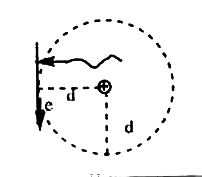A small metal plate is kept at a distance d form a singly ionized, fixed ion. A monochromatic light beam is incident on the metal plate and photoelectrons are emitted. Find the maximum wavelength of the light beam so that some of the photoelectrons may go round the ion along a circle.
Electron is moving around the ion in a Circle of radius .d.. Centripetal force is provided by Electrostatic force
14πε0e2d2=mV2d,∴mV2=14πε0e2d
∴K.E=18πε0e2d .......(1)
But K.Emax=hcλ−W ......(2)
∴hcλ−W=e28πε0d
∴λ=hc8πε0de2+8πε0dW

Topper's Solved these Questions
- BOOK - AAKASH SERIESCHAPTER - DUAL NATURE OF RADIATION AND MATTEREXERCISE - EXERCISE-I65videos
DUAL NATURE OF RADIATION AND MATTER
- BOOK - AAKASH SERIESCHAPTER - DUAL NATURE OF RADIATION AND MATTEREXERCISE - EXERCISE-I ASSERTION AND REASON4videos
DUAL NATURE OF RADIATION AND MATTER
- BOOK - AAKASH SERIESCHAPTER - CURRENT ELECTRICITYEXERCISE - EXERCISE - IA2videos
CURRENT ELECTRICITY
- BOOK - AAKASH SERIESCHAPTER - ELECTRIC CHARGES AND FIELDSEXERCISE - Practice Exercise57videos
ELECTRIC CHARGES AND FIELDS
Similar Questions
A small metal plate of work function ϕ is kept at a distance r from a singly ionised, fixed ion. A monochromatic light beam is incident on the metal plate and photoelectrons are emitted. Find maximum wavelength of the light beam so that some of that electrons may go round the ion along a circle.
View SolutionLight of wavelength 2000Å is incident on a metal surface of work function 3.0 eV. Find the minimum and maximum kinetic energy of the photoelectrons.
View Solution
Knowledge Check
- Question 1 - Select One
The photoeletric threshold 4v is incident on the metal is v. When light of freqency 4v is incident on the metal, the maximum kinetic energy of the emitted photoelectron is
A4hvB3hvC5hvD5hv2 - Question 2 - Select One
A light of wavelength 600 nm is incident on a metal surface. When light of wavelength 400 nm is incident, the maximum kinetic energy of the emitted photoelectrons is doubled. The work function of the metals is
A1.03 eVB2.11 eVC4.14 eVD2.43 eV
Light of wavelength 400 nm strikes a certain metal which has a photoelectric work function of 2.13eV. Find out the maximum kinetic energy of the photoelectrons
View SolutionLight of wavelength 3000Å is incident on a metal surface whose work function is 1 eV. The maximum velocity of emitted photoelectron will be
View SolutionA small piece of cesium metal ϕ=1.9eV is kept at a distance of 20 cm form a large metal plate having a charge density of 1.0×10−9Cm−2 on the surface facing the cesium piece. A monochromatic light of wavelength 400nm is incident on the cesium piece. Find the minimum and the maximum kinetic energy of the photoelectrons reaching the large metal plate. Neglect any change in electric field due to the small piece of cesium present.
View SolutionSome questions (Assertion-Reason Type) are given below. Each question contains Statement I (Assertion) and statement II(reason). Each question has 4 choices (a),(b),(c ) and (d) out of which only one is correct. So select the correct choise.
a. Statement I is True, Statement II is True,Statement II is a correct explanation for Statement I
b. Statement I is True, Statement II is True, Statement II is NOT a correct ecplanation for Statement I
c. Statement I is True, Statement II is False .
d. Statement I is false, Statement II is True.
Statement:I Though light of a single frequency (monochromatic light) is incident on a metal, the energies of emitted photoelectrons are different.
Statement II: The energy of electrons just after they absorb photons incident on the metal surface may be lost in collision with other atoms in the metal before the electron is ejected out of the metal.View SolutionA light of intensity 16 mW and energy of each photon 10 eV incident on a metal plate of work function 5 eV and area 10−4m2 then find the maximum kinetic energy of emitted electrons and the number of photoelectrons emitted per second if photon efficiency is 10%.
View SolutionA metallic surface is irradiated with monochromatic light of variable wavelength. Above a wavelength of 5000Å no photoelectrons are emitted from the surface. With an unknown wavelength, stopping potential fo 3V is neceddsry ot eliminate the photocurrent. Find the unknown wavelenght.
View Solution

